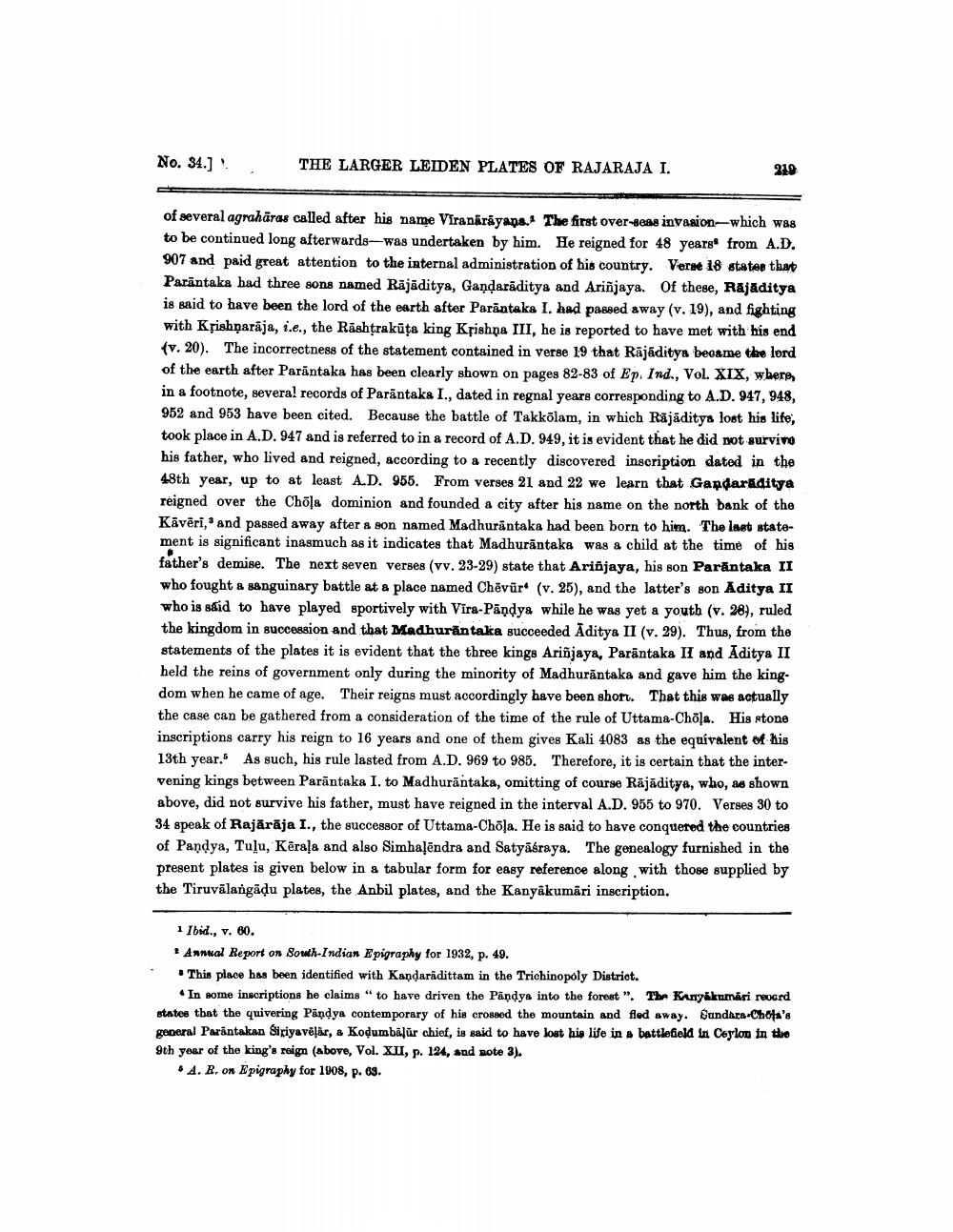________________
No. 34.] :
THE LARGER LEIDEN PLATES OF RAJARAJA I.
219
of several agrahāras called after his name Viranarayana. The first over-seas invasion-which was to be continued long afterwards--was undertaken by him. He reigned for 48 years from A.D. 907 and paid great attention to the internal administration of his country. Verse 18 states that Paräntaka had three sons named Rajāditya, Gandarāditya and Ariñjaya. Of these, Rajaditya is said to have been the lord of the earth after Parāntaka I. had passed away (v. 19), and fighting with Krishnarāja, i.e., the Rashtrakūta king Krishna III, he is reported to have met with his end (v. 20). The incorrectness of the statement contained in verse 19 that Rājāditya became the lord of the earth after Parāntaka has been clearly shown on pages 82-83 of Ep. Ind., Vol. XIX, where in a footnote, several records of Parantaka I., dated in regnal years corresponding to A.D. 947,948, 952 and 953 have been cited. Because the battle of Takkölam, in which Rājāditya lost his life, took place in A.D. 947 and is referred to in a record of A.D. 949, it is evident that he did not survivo his father, who lived and reigned, according to a recently discovered inscription dated in the 48th year, up to at least A.D. 955. From verses 21 and 22 we learn that Gapdarāditya reigned over the Chõļa dominion and founded a city after his name on the north bank of the Kāvēri,and passed away after a son named Madhurantaka had been born to him. The last statement is significant inasmuch as it indicates that Madhurāntaka was a child at the time of his father's demise. The next seven verses (vv. 23-29) state that Ariñjaya, his son Parantaka II who fought & sanguinary battle at a place named Chevūr* (v. 25), and the latter's son Aditya II who is said to have played sportively with Vira-Pāņdya while he was yet a youth (v. 28), ruled the kingdom in succession and that Madhurantaka succeeded Aditya II (v. 29). Thus, from the statements of the plates it is evident that the three kings Ariñjaya, Parāntaka II and Aditya II held the reins of government only during the minority of Madhurāntaka and gave him the kingdom when he came of age. Their reigns must accordingly have been short. That this was actually the case can be gathered from a consideration of the time of the rule of Uttama Chola. His stone inscriptions carry his reign to 16 years and one of them gives Kali 4083 as the equivalent of his 13th year. As such, his rule lasted from A.D. 969 to 985. Therefore, it is certain that the intervening kings between Parantaka I. to Madhurāntaka, omitting of course Rājāditya, who, as shown above, did not survive his father, must have reigned in the interval A.D. 955 to 970. Verses 30 to 34 speak of Rajäräja I., the successor of Uttama-Chöļa. He is said to have conquered the countries of Pandya, Tulu, Kerala and also Simhalindra and Satyä raya. The genealogy furnished in the present plates is given below in a tabular form for easy reference along with those supplied by the Tiruvālangāļu plates, the Anbil plates, and the Kanyākumāri inscription.
1 Ibid., v. 60.
1 Annual Report on Sowth-Indian Epigraphy for 1932, p. 49. . This place has been identified with Kandarādittam in the Trichinopoly District.
• In some inscriptions he claims to have driven the Pandys into the forest". The Kanyakumari record states that the quivering Pandya contemporary of his crossed the mountain and fled away. Sundara-Chota's general Parantakan Siriyavēļār, a KodumbäJür chief, is said to have lost his life in a battlefield in Ceylon in the 9th year of the king's reign (above, Vol. XII, p. 124, and note 3).
• A. R. on Epigraphy for 1908, p. 69.




